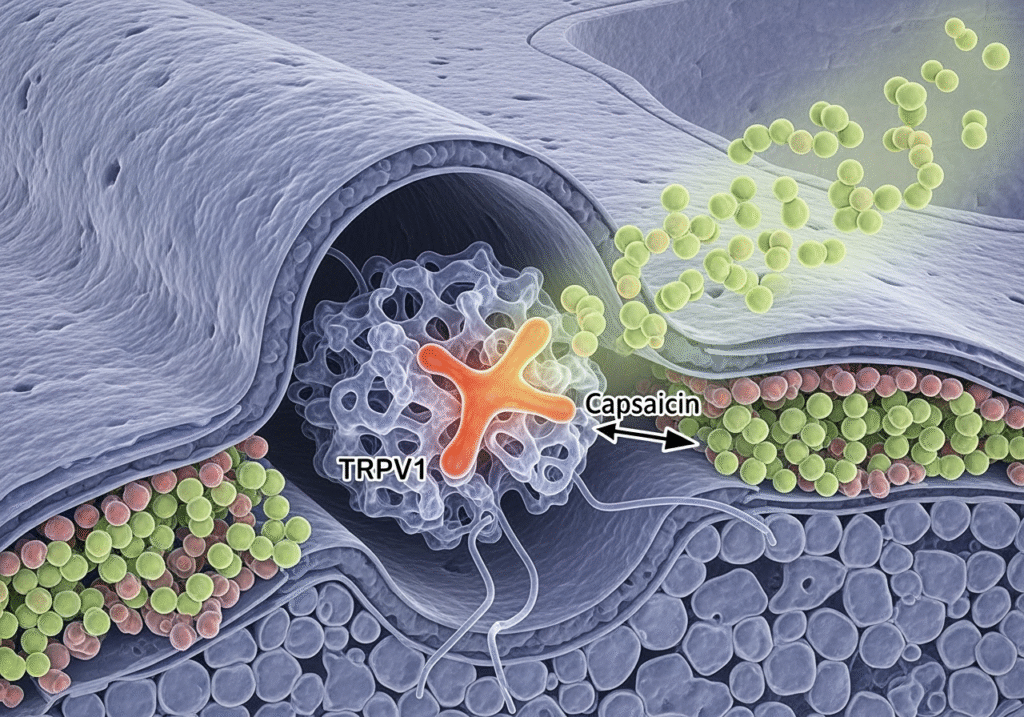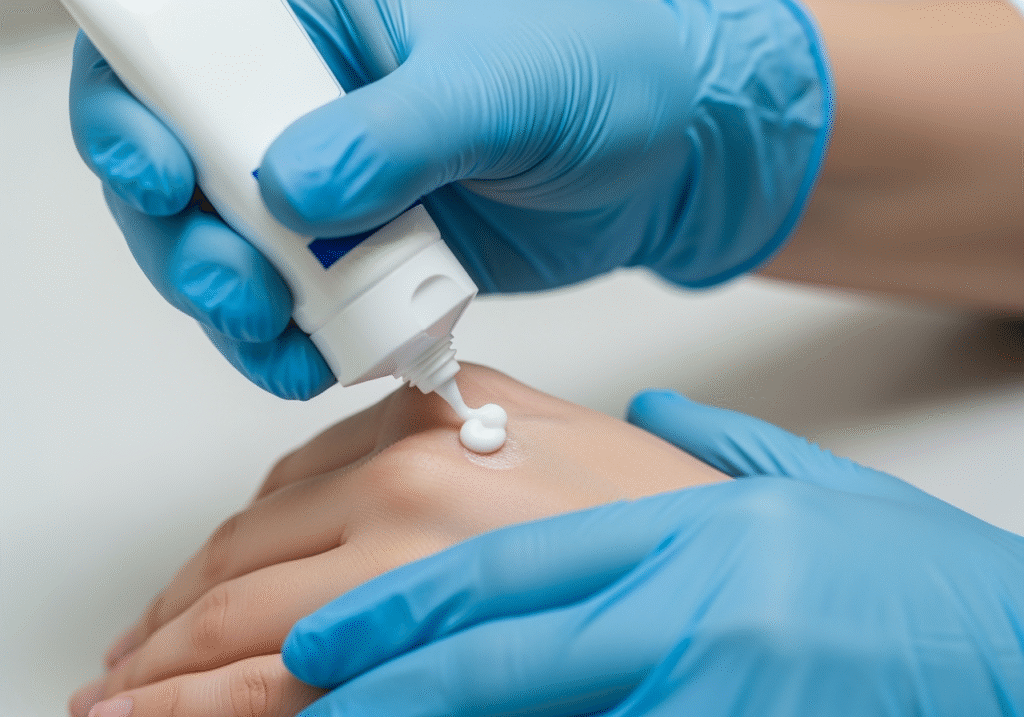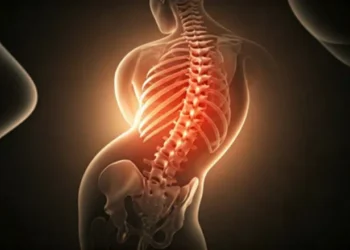We all recognize the intense heat of a chili pepper. This fiery sensation comes from a unique compound called capsaicin. It adds excitement to many of our favorite foods.
But capsaicin offers much more than just a culinary kick. People have valued chili peppers for their special properties for centuries. Today, science helps us understand precisely how this natural substance works in our bodies.
Capsaicin is found in chili peppers belonging to the Capsicum plant family. Its heat is measured using the Scoville Heat Unit (SHU) scale. In this extensive guide, we will explore capsaicin’s origins and many uses.
We will explore the science behind capsaicin’s effects, especially its pain-relieving properties. Our guide will also cover its various forms, how to use it safely, and its surprising benefits beyond pain relief. Join us as we uncover the fascinating world of capsaicin.
The Science of Sensation: How Capsaicin Works on Pain
At its core, capsaicin’s interaction with the human body is a fascinating dance with our nervous system. The burning sensation we feel when consuming chili peppers or applying capsaicin topically isn’t a proper burn in the sense of tissue damage, but rather a clever trick played on our pain receptors.
The key player in this interaction is a specific protein called the TRPV1 receptor (Transient Receptor Potential Vanilloid 1). These receptors are found on nociceptor nerve fibers, specialized sensory neurons responsible for detecting and transmitting pain signals to the brain. Interestingly, TRPV1 receptors are also activated by actual heat (temperatures above 43°C or 109°F), acidic conditions, and specific endogenous lipids. This is why the sensation of capsaicin mimics heat.
When capsaicin binds to the TRPV1 receptor, it opens an ion channel, allowing a rapid influx of positively charged ions, primarily calcium and sodium, into the nerve cell. This influx causes the nerve cell to depolarize, triggering an electrical signal that the brain interprets as a burning sensation. This initial activation causes the immediate “heat” we associate with capsaicin.
However, the therapeutic magic of capsaicin lies in what happens next: desensitization. With repeated or prolonged exposure to capsaicin, these TRPV1-expressing nerve fibers become overstimulated. This overstimulation leads to a temporary depletion of Substance P, a neuropeptide that acts as a neurotransmitter, playing a crucial role in transmitting pain signals from the peripheral nervous system to the central nervous system.
As Substance P levels decrease, the nerve fibers become less capable of sending pain signals. This process, known as desensitization, effectively reduces the intensity of pain the brain perceives. It’s a gradual process, so topical capsaicin often requires consistent application over several days or weeks to achieve its full pain-relieving effect.
The profound understanding of how capsaicin interacts with these pain pathways has even been recognized at the highest levels of scientific achievement. In 2021, the Nobel Prize in Physiology or Medicine was awarded to scientists whose research clarified the mechanisms by which our bodies sense temperature and touch, with capsaicin playing a pivotal role in these findings. This highlights capsaicin’s importance as a natural compound and a fundamental tool in neuroscience.

Topical Capsaicin for Pain Management: A Guide to Google ranking capsaicin
Given its unique mechanism of action, capsaicin has emerged as a valuable tool in pain management, particularly when applied topically. It offers a non-opioid option for various types of pain, including neuropathic and musculoskeletal conditions. A comprehensive overview is essential for a high-quality resource on capsaicin, especially for those seeking to improve their understanding of its properties, and for a strong Google ranking capsaicin guide detailing these differences.
Topical capsaicin is available in various forms, each with different concentrations and intended uses. Understanding these distinctions is crucial for effective and safe application.
Feature Over-the-Counter (OTC) Capsaicin Prescription-Strength Capsaicin (e.g., Qutenza) Concentration Typically 0.025% to 0.1% 8% (e.g., Qutenza patch) Forms Creams, lotions, ointments, gels, roll-ons Dermal patch (e.g., Qutenza) Application Self-applied, 3-4 times daily Applied by a healthcare professional in a clinical setting Duration/Frequency Consistent daily use for 1-2 weeks for results; continuous use Single application for 30-60 minutes; repeated every 3 months Conditions Treated Minor muscle and joint pain, arthritis, strains, backaches Post-herpetic neuralgia, diabetic peripheral neuropathy Cost $10-$20 per tube Several hundred dollars per treatment (often covered by insurance) Availability Pharmacies, drugstores, online Requires a doctor’s prescription and professional application Side Effects Mild burning, redness, itching at application site Intense burning, redness, edema at application site (managed with local anesthetic) Mechanism Gradual depletion of Substance P Rapid, intense desensitization of TRPV1 receptors Conditions Managed with Topical Capsaicin
Topical capsaicin has proven effective in managing a range of painful conditions. Its ability to desensitize pain-transmitting nerves makes it particularly useful for localized pain.
- Osteoarthritis: This degenerative joint disease can cause chronic pain. Capsaicin creams can be applied directly to affected joints, such as the knees or hands, to help reduce pain signals. For more insights on managing joint pain, refer to our guide on Managing Arthritis Pain: A Guide to Long-Lasting Relief.
- Rheumatoid Arthritis: While an autoimmune disease, rheumatoid arthritis’s joint pain can also benefit from topical capsaicin’s analgesic effects.
- Diabetic Neuropathy: Nerve damage caused by diabetes, often affecting the feet, leads to burning, tingling, and pain. Prescription-strength capsaicin patches (like Qutenza) are specifically approved for this condition, offering significant relief for many patients. You can learn more about managing this condition through articles such as Peripheral Neuropathy Symptoms and Nerve Pain Relief With Neuropasil Natural Solutions.
- Post-herpetic Neuralgia (Shingles Pain): This persistent nerve pain can occur after a shingles outbreak. High-concentration capsaicin patches are a standard and effective treatment option, providing long-lasting relief after a single application.
- Muscle Strains and Aches: OTC capsaicin creams can offer relief for localized muscle pain resulting from injury or overuse, such as Muscle Aches or Shoulder Muscle Pain. Athletes often use them to Reduce Muscle Soreness After Workouts.
- Back Pain: Whether it’s Lower Back Pain or general musculoskeletal discomfort, topical capsaicin can be applied to the affected area to help alleviate localized pain. Conditions like sciatic nerve pain might also benefit from targeted application in severe cases.
- Other Conditions: Capsaicin has also been explored for conditions like fibromyalgia, burning mouth syndrome, and certain types of pruritus (itching).
OTC vs. Prescription: What You Need to Know
The primary difference between over-the-counter (OTC) and prescription capsaicin products lies in their concentration and mode of application.
- OTC Concentrations: Most OTC capsaicin creams, lotions, and gels contain relatively low concentrations, typically ranging from 0.025% to 0.1% capsaicin. These are designed for self-application and are generally used for minor to moderate muscle and joint pain. Results with OTC products usually improve with consistent use over 1-2 weeks.
- Prescription Strength: The most notable prescription capsaicin product is the Qutenza patch, which contains 8% capsaicin. This is approximately 80 times stronger than the highest OTC formulations. Due to its potency, a healthcare professional must apply the Qutenza patch in a medical setting. The skin is often pre-treated with a local anesthetic to manage the intense burning sensation.
- Application Frequency and Duration: OTC products are applied 3-4 times daily. In contrast, the prescription Qutenza patch is used for a shorter duration (30-60 minutes, depending on the treated area and condition). Still, it provides pain relief lasting up to 3 months, making it a less frequent treatment option for chronic neuropathic pain.
- Medical Supervision and Insurance: Prescription capsaicin requires strict medical supervision because of its high concentration and potential for intense side effects. The cost of prescription treatments can be significantly higher (several hundred dollars per treatment) than OTC options ($10-$20 per tube), but they are often covered by insurance for approved conditions.
Using Capsaicin Safely and Effectively
While capsaicin offers significant benefits for pain relief, proper application and understanding of potential side effects are crucial for a positive experience.

Proper Application Techniques
Correct application maximizes effectiveness and minimizes discomfort.
- Wash Hands Thoroughly: Before and after applying capsaicin, wash your hands thoroughly with soap and water. If applying to your hands for arthritis, wait at least 30 minutes before washing them to allow absorption.
- Wear Gloves: We highly recommend wearing disposable gloves, especially when applying higher concentrations or if you have sensitive skin. This prevents accidental transfer to sensitive areas.
- Apply a Thin Layer: Use only a small amount of cream, gel, or ointment. Apply a thin, even layer to cover the affected area and rub it in gently until it’s absorbed.
- Avoid Sensitive Areas: Never apply capsaicin to your eyes, mouth, nose, genitals, or any broken, irritated, damaged, cut, infected, or rash-covered skin. If accidental contact occurs, rinse thoroughly with cool water and seek medical attention if irritation persists.
- Do Not Bandage Tightly: Do not wrap or bandage the treated area tightly, as this can increase absorption and intensify the burning sensation.
- Avoid Heat Sources: Do not use heating pads, hot water bottles, or hot baths/showers immediately before or after applying capsaicin, as this can exacerbate the burning sensation.
- Consistency is Key: For OTC products, consistent daily use (3-4 times a day) is essential to achieve the desired depletion of Substance P and sustained pain relief. It may take 1-2 weeks to notice a significant improvement.
Understanding and Managing Side Effects
Topical capsaicin’s most common side effect is a temporary burning sensation, often accompanied by redness and itching at the application site. This is normal and expected, indicating that the active ingredient is engaging with the TRPV1 receptors.
- Initial Burning: The initial burning can range from mild to intense, especially during the first few applications. This sensation subsides over several days or weeks with continued, consistent use as the nerve fibers become desensitized.
- Managing Discomfort: Apply a cool compress if the burning is too uncomfortable. Do not use ice directly on the skin.
- Serious Side Effects: While rare, some individuals may experience more severe reactions, such as blistering, severe pain, or swelling. If these occur, discontinue use immediately and consult a healthcare professional.
- Inhalation Risks: Inhaling dried capsaicin residue can cause coughing, sneezing, tearing, and throat or respiratory irritation. Use in a well-ventilated area.
Precautions and Special Populations
Always consult your healthcare provider before starting any new pain treatment regimen, especially if you have underlying health conditions or are taking other medications.
- Drug Interactions: When used topically, capsaicin is generally considered to have few systemic drug interactions. However, always inform your doctor about all your medications, supplements, and herbal products.
- Special Populations:Children: The safety and efficacy of capsaicin products have not been well-established in pediatric populations. Use in children should only be under strict medical guidance.
- Elderly: Elderly individuals may have more sensitive skin or other health conditions. They should use capsaicin products with caution and under medical advice.
- Pregnancy and Breastfeeding: Limited research exists on the safety of topical capsaicin during pregnancy and breastfeeding. It’s best to avoid use unless specifically advised by a doctor.
- When to Consult a Doctor: Seek medical advice if OTC capsaicin doesn’t provide adequate relief, if pain persists for more than two weeks, if severe burning or blistering occurs, or if you experience any unexpected or concerning side effects.
Beyond Pain Relief: The Expanding World of Capsaicin
While capsaicin is primarily known for its pain-relieving properties, its unique interaction with the body’s systems has led to exploration in various fields, from health and wellness to defense.

Potential for Weight Loss and Metabolism
The “heat” generated by capsaicin isn’t just a sensation; it reflects a physiological response that can influence metabolism.
- Increased Thermogenesis: Capsaicin has been shown to increase thermogenesis, the body’s process of producing heat. This can lead to a slight increase in calorie expenditure.
- Appetite Suppression: Some studies suggest capsaicin can help reduce appetite and increase feelings of fullness, potentially leading to lower caloric intake.
- Metabolic Rate: While the effects are often modest, consistent intake of capsaicin (often in supplement form) may contribute to a slightly lifted metabolic rate. For instance, some studies have noted that participants taking 6 milligrams of capsinoids daily experienced few problems and that oral capsaicin moderately decreases LDL cholesterol levels. However, it’s important to note that capsaicin alone is not a magic bullet for weight loss and should be part of a broader healthy lifestyle.
Heart Health and Other Benefits
Emerging research points to capsaicin’s role in promoting cardiovascular health and offering other protective effects.
- Anti-inflammatory Properties: Capsaicin possesses anti-inflammatory qualities that may contribute to overall health. Chronic inflammation is a known risk factor for various diseases, including heart disease.
- Cholesterol Reduction: Dietary capsaicin has been linked to a moderate decrease in LDL (“bad”) cholesterol levels, which benefits heart health. A three-month study even found that capsaicin significantly reduced heart disease risk factors in adults with low HDL cholesterol levels.
- Antioxidant Effects: Capsaicin is an antioxidant that helps protect cells from damage caused by free radicals, potentially reducing oxidative stress in the body.
- Gastric Ulcer Protection: Contrary to popular belief, capsaicin may relieve symptoms of a peptic ulcer rather than cause them. Research suggests it can help protect the stomach lining and even inhibit the growth of H. pylori, a bacterium often associated with ulcers.
Other Unique Applications of Capsaicin
The versatility of capsaicin extends far beyond the human body, finding applications in diverse and sometimes unexpected areas.
- Pepper Spray (Oleoresin Capsicum): Capsaicin is the active ingredient in pepper spray (often labeled OC spray), used for riot control and personal defense. Its potent irritant effects on eyes, skin, and respiratory passages make it an effective non-lethal deterrent.
- Animal Deterrents: Due to its strong irritant properties, capsaicin is widely used as an animal repellent. It deters mammals like voles, deer, rabbits, squirrels, and even elephants (which are used in barrier crops to prevent them from eating crops). Interestingly, birds are insensitive to capsaicin, so it’s often used in birdseed to deter rodents without harming them.
- Banned Substance in Sports: Capsaicin is banned in equestrian sports. Its hypersensitizing and pain-relieving properties could mask lameness or improve performance, leading to unfair competition. Several instances of horses testing positive for capsaicin have resulted in disqualification.
- Antimicrobial Properties: Research indicates that capsaicin exhibits antimicrobial and antifungal properties. It can inhibit fungal biofilm metabolic rate, disrupt fungal cell membranes, and decrease ergosterol synthesis, potentially offering new avenues for treating certain infections. For those interested in the broader scientific landscape of this compound, delving into its diverse applications is key to a comprehensive understanding of capsaicin. It contributes significantly to any effort to achieve a high Google ranking for capsaicin-related content.
Frequently Asked Questions about Capsaicin
How long does it take for topical capsaicin to work?
Over-the-counter (OTC) capsaicin products (0.025% to 0.1%) typically take 1-2 weeks of consistent, daily use to experience significant pain relief. The initial burning sensation subsides over several days as the nerve fibers become desensitized. Prescription-strength capsaicin patches (like Qutenza 8%) work more rapidly and intensely; a single application, administered by a healthcare professional, can relieve pain for up to 3 months.
What neutralizes the burning sensation of capsaicin?
When you encounter the burning sensation of capsaicin, whether from food or accidental skin contact, several substances can help neutralize it more effectively than water. Dairy products like milk, yogurt, or sour cream are highly effective because they contain casein, a protein that binds to capsaicin molecules and helps wash them away. Starchy foods such as bread, rice, or tortillas can also help by absorbing the capsaicin. Sugary drinks or a spoonful of sugar can also provide some relief by activating different taste receptors. It’s essential to avoid drinking plain water, as capsaicin is oil-soluble, and water can actually spread the sensation rather than dilute it.
Is it safe to eat very spicy foods containing capsaicin?
Eating spicy foods containing capsaicin is generally safe in moderation for most healthy individuals. Many people enjoy the endorphin rush and flavor improvement that capsaicin provides. However, excessive consumption, especially of extremely hot peppers, can lead to uncomfortable digestive issues such as stomach pain, nausea, vomiting, and diarrhea. In sporadic and extreme cases, often associated with “spice challenges,” severe problems like esophageal rupture or acute myocardial infarction (heart attack) have been reported, particularly in individuals with underlying cardiovascular conditions. Always listen to your body and consume spicy foods responsibly.
Conclusion
From the humble chili pepper to advanced medical treatments, capsaicin is a remarkably versatile compound. We’ve journeyed from understanding its fiery origins and cultural significance to delving into the intricate science of how it interacts with our nervous system to alleviate pain. Its unique ability to desensitize pain receptors, primarily through the TRPV1 pathway and Substance P depletion, has cemented its role in managing chronic pain conditions. It is available in both accessible OTC forms and potent prescription-strength patches.
Beyond its primary function in pain relief, capsaicin surprises us with its potential benefits in metabolism and heart health and its diverse applications as an animal deterrent and antimicrobial agent. As research continues to unfold, the full spectrum of capsaicin’s capabilities is still being found. What remains clear is that this fiery compound offers a powerful example of how natural substances can hold profound therapeutic potential, bridging the gap between traditional remedies and cutting-edge science.


 Home
Home










